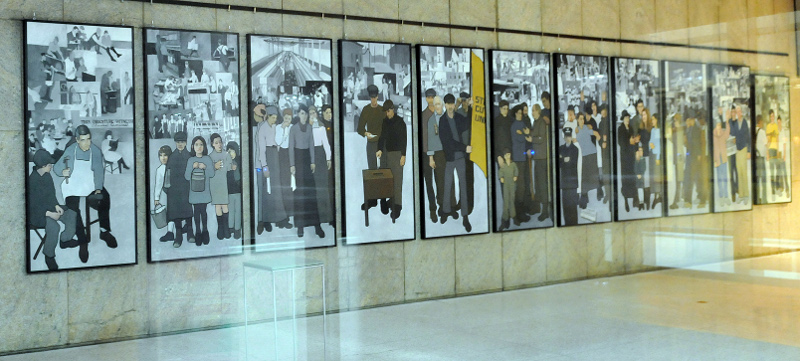PORTLAND – The state paid more than $6,000 to remove, store and ultimately relocate a labor mural that Gov. Paul LePage removed from the Maine Department of Labor building lobby, officials said. Part of the cost ended up being paid by a Republican group that tried to raise money to purchase the mural.
The governor created an uproar nearly two years ago when he ordered the mural’s removal because he believed it presented a one-sided view of history that overlooked the contributions of entrepreneurs.
Hidden for nearly 22 months, the mural came out of storage last weekend and is now displayed in an atrium that serves as the entryway to the Maine State Museum, Maine State Library and Maine State Archives.
The cost of crating and storing the labor mural was $530, and transportation costs were $690, the Department of Labor told The Associated Press in response to a Freedom of Access request. Framing and installation at the new venue added up to another $4,850, the LePage administration said. The Maine State Museum also purchased a security camera, estimated to cost about $150, to protect the mural.
A silver lining was that framing and installation costs were defrayed by a Republican group, Aroostook Republicans, which made a donation to the Maine State Museum after unsuccessfully trying to raise enough money to pay back a federal grant so the state could take ownership of the mural.
“The money that was going to be used to buy the mural was used to put it back on display,” said Julie Rabinowitz, a spokeswoman for the Department of Labor.
The mural is still owned by the Department of Labor, but it will be displayed in the atrium under a three-year, renewable display agreement.
The mural’s scenes include World War II’s Rosie the Riveter, a 1937 shoe workers’ strike in Maine and New Deal-era U.S. Labor Secretary Frances Perkins, among others.
Its removal led to protests and a federal lawsuit. The U.S. Department of Labor also got into the act, accusing LePage of violating terms of the $60,000 grant used to pay for most of the mural’s cost.
LePage’s spokeswoman said last week that the governor had no objection to the mural’s new location.
Aroostook Republicans, which wanted to pay off the federal government’s contribution, fell far short of its goal but donated $2,333 to be used as the museum saw fit, said Sheila McDonald, the museum’s deputy director. Of that sum, $2,250 was applied to the mural’s relocation, she said.
At its original location, the mural pieces, each about 7 feet tall and weighing 45 pounds, were bolted into drywall, McDonald said. At the new location, a new mounting system was required for the museum’s granite walls, but it can be used again if it’s moved, she said.
Judy Taylor, the artist who created the mural, signed off on the new arrangement.
Rabinowitz said the new site for the mural ensures that more people will see it, since the museum draws more visitors than the department’s offices.
The long battle over the now-famous mural began in 2011, soon after LePage, a Republican, was inaugurated.
The governor criticized the mural as a one-sided view sympathetic to unions. He compared it at one point to Communist propaganda in North Korea.
LePage’s administration quietly took the mural down over a weekend and stored it at an undisclosed location. Artists, labor advocates and others criticized the decision, saying he had no authority to arbitrarily remove the artwork.
Five Mainers, including three artists, later filed a lawsuit claiming the removal violated the First Amendment right to free speech of the artists.
The case made its way to federal court in Maine, where U.S. District Judge John Woodcock Jr. sided with LePage. The case was then sent to the U.S. 1st Circuit Court of Appeals in Boston, which affirmed the Maine federal court’s view. The Appeals Court ruled that the mural represented government speech, a special category of statement that was the government’s to make or withdraw at its discretion.
Jeffrey Neil Young, the attorney who brought the lawsuit against the state, said the museum is an appropriate location for the mural.
Send questions/comments to the editors.



Success. Please wait for the page to reload. If the page does not reload within 5 seconds, please refresh the page.
Enter your email and password to access comments.
Hi, to comment on stories you must . This profile is in addition to your subscription and website login.
Already have a commenting profile? .
Invalid username/password.
Please check your email to confirm and complete your registration.
Only subscribers are eligible to post comments. Please subscribe or login first for digital access. Here’s why.
Use the form below to reset your password. When you've submitted your account email, we will send an email with a reset code.